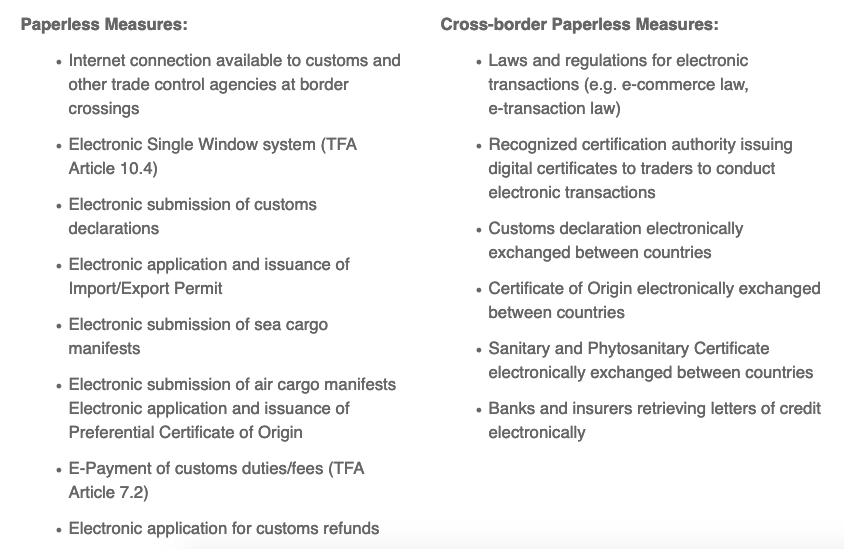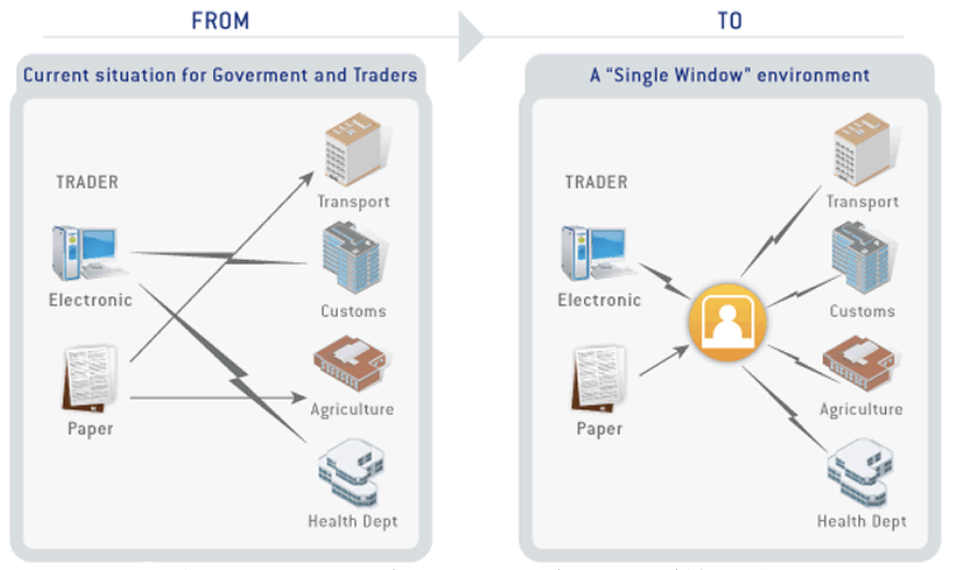
A country’s international logistics performance depends on the extent and modernity of its trade facilitation reform (World Bank, 2018). National trade facilitation committees (NTFCs) are an institutional obligation for members of the World Trade Organization (WTO) because they serve as multi-agency platforms for stakeholder engagement. These partnerships generate consensus via ‘national roadmaps’ to customise a country’s approach to update its domestic interface with global markets through implementation of the WTO Trade Facilitation Agreement (TFA) (UNCTAD, 2017).
This article explores how the context for crafting trade policy is changing, particularly when considering the digitalisation of trade, and what it could imply for the role of NTFCs in fostering modernisation.
Digitalisation and the changing landscape of trade facilitation reform
Mainstreaming digital technologies in trade facilitation reform is not merely an obligation for most countries, it is a necessity. Indeed, conditions for the cost-effective and rapid movement of goods can have as much to do with a product’s data as with a product itself. This is increasingly the case as the shift toward paperless trade is premised on policy delivery and compliance through digital means.
Yet, disparate and emergent rules – regulations (e.g. General Data Protection Regulation, European data strategy), arrangements (e.g. Digital Economy Partnership Agreement), framework treaties (e.g. Cross-border Paperless Trade in Asia and the Pacific) and provisions (e.g. e-commerce chapters in trade agreements) – highlight a need to coordinate all relevant legal and technical communities when crafting “future proof” policies at the national level.
In addition, modern supply chain models specify relationships between data entities in international sales / transport contracts and demand a reformulation of measures in accordance with the broadening scope of channels (e.g. cross-border e-commerce) and modes of policy delivery (e.g. the internet).
However, the results of the 2019 United Nations (UN) global survey on digital and sustainable trade facilitation indicate a lag in adoption of information and communication technology (ICT) solutions by governments. Examining the survey results, measures for cross-border paperless trade have progressed to approximately half the rate of implementation as compared to measures for transparency, on average. Conversely, measures for institutional cooperation have moved forward in most countries and NTFCs are starting to be seen as permanent fixtures after TFA implementation. With averages of 63 per cent progress for paperless measures and 38.6 per cent progress for cross-border paperless trade measures (see Figure 1), global commerce has yet to be radically transformed by technology-enabled policies.
Figure 1. Global implementation of trade facilitation and paperless trade, 2019

Source: Author, based on data from the 2019 UN Global Survey on Digital and Sustainable Trade Facilitation
From compliance to compatibility: a ‘rules as data’ approach to policy modernisation
The legal objective of trade facilitation reform is to create a clear, concise and transparent framework that adheres to multilateral expectations. The Trade Facilitation Agreement foresees that WTO members publish information on import, export and transit procedures to the internet (Article 1.2). Commitments also refer to systems for electronic payments of duties/fees (Article 7.2) and deployment of a national single window (Article 10.4). Countries are expected to use ICT to the “extent practicable” to realise these measures and are informed by UN recommendations and standards.
Examples of recommendations and standards for data include the UN Centre for Trade Facilitation and Electronic Business (UN/CEFACT) Reference Data Models (RDMs) and the World Customs Organization (WCO) data model. New legal frameworks for cross-border data exchange via single window systems are steered by UN Commission on International Trade Law (UNCITRAL) model laws and other conventions. Many of the measures in the UN survey go beyond requirements under the trade facilitation agreement (see Table 1).
Table 1. Measures for paperless and cross-border paperless trade
Source: Adapted measure categories from the 2019 UN Global Survey on Digital and Sustainable Trade Facilitation
At present, progress toward implementation of the TFA is bottlenecked by forces that exacerbate traditional political-economic complexity – crafting policy must include stakeholder agreement and capacity for procuring or implementing technology-enabled solutions. The shift to policy delivery and compliance through digital means is necessarily achieved through ICTs, but access to technology may not be equal nor economically viable given the potential costs of licensing “off the shelf” or developing in-house solutions.
The NTFC mechanism allows for coordination and exchange of information on legal-technical needs with domestic, regional and international partners. Such partnerships have already improved the implementation of measures, including for national single window systems (see Figure 2). As diverse stakeholder engagement platforms hosted in WTO member countries, NTFCs can support each step in the digitalisation of trade policy.
Figure 2. Toward a national electronic “single window” environment

Source: “UNECE Recommendation No. 33.” (2005) United Nations Centre for Trade Facilitation and Electronic Business
Uniquely positioned, national committees have the potential to augment modernisation efforts through computer-based legal design approaches. Well known in the field of computational law, these methods can specify executable rules in the form of algorithms that refer to calculations or data sufficiency requirements (Schartum, 2016). By constructing and publishing “control tables” in an agnostic form to the internet, official data sources / criteria (e.g. real-time tariff schedules) can power measures for customs modernisation. (Agnostic forms imply conformance with global data standards and loose coupling with programming languages, operating systems or transmission networks.)
Over time, contributions lead to the advent of an “internet of rules” or ubiquitous online access to rules relevant to any cross-border transaction (Potvin et al, 2020). With such a “rules as data” approach, systems mandated by the Trade Facilitation Agreement can be fast-tracked: data-driven trade rules simplify deployment of a single window, enhance the automation potential of data/document sources and lead to greater interoperability among public and private rules systems. For example, UNCTAD’s popular Automated System for Customs Data (ASYCUDA) – a customs management system for international trade and transport operations – could benefit from rules expressed with a cross-platform approach to allow for seamless exchange between the Java-based ASYCUDAWorld software and other, differently designed, solutions for the digitalisation of complex trade procedures.
Prioritising developing countries: advancing “future-proof” reforms with NTFCs
Similar to trade facilitation reform, diverse people and technologies enable the existence and advancement of the internet. Under the auspices of an NTFC, partnerships that utilise a “rules as data” approach can bridge the widening gap between regulatory and technological change while creating an apparatus for governments to increase revenues. These approaches to reform entail that the rules of trade are not only well codified but expressed in ways that are adaptable to future needs and more functional. The rapid digitalisation of trade suggests changes to traditional policymaking that involve better addressing cross-border e-commerce, trade in services and the data required for automation.
Typically, the level of development of a country and its infrastructure places a constraint on national committees and their capacity to leverage technology to enhance trade policy design and delivery. Indeed, the sustainability of NTFCs continues to be a challenge in developing and least-developed countries (LDCs). Only 27 per cent of national committees have a budget to implement activities and common obstacles include resource constraints, resistance to change and lack of political will (UNCTAD, 2020).
Although governments of developing countries face technical barriers, information asymmetries and relatively lower, current, use of ICT solutions, NTFCs will continue to drive the modernisation of trade. A “rules as data” approach can help to overcome limitations: countries can meet and exceed TFA principles through both co-drafting and coding of functional policies before choosing a model of technology adoption.
At present, the application of existing and envisaged rules is not able to meet the technical needs of the digitally enabled economy. Using new modes to deliver trade facilitation policies builds on the reality that the internet could be a powerful enabler of trade and bolster transparency efforts on several fronts, namely computational rules that apply to cross-border transactions. As platforms, NTFCs must seek to create a better environment for trade by truly actualising the domestic policy / technology interface with international markets.
♣♣♣
Notes:
- This blog post appeared first on the site of the United Nations Conference on Trade and Development (UNCTAD).
- The post expresses the views of its author(s), not the position of LSE Business Review or the London School of Economics.
- Featured image by geralt, under a Pixabay licence
- When you leave a comment, you’re agreeing to our Comment Policy
 Craig Atkinson is the director of Lexmerca International Trade, a consulting firm working at the nexus of trade, innovation and sustainable development. He is also a consultant with the United Nations International Trade Centre and a research fellow at Stanford University’s Law School. Craig’s research focuses on digital technologies that are altering the design and delivery of trade policy. His previous professional experience includes positions with two national trade promotion organisations – the Australian Trade Commission and the Canadian Trade Commissioner Service – and in the private sector. He holds a Master’s degree in international trade (international law and economics) and a Master of Arts in political studies (international development) from the University of Saskatchewan. Additionally, in 2017, Craig was a visiting student at LSE. craig.atkinson@lexmerca.com
Craig Atkinson is the director of Lexmerca International Trade, a consulting firm working at the nexus of trade, innovation and sustainable development. He is also a consultant with the United Nations International Trade Centre and a research fellow at Stanford University’s Law School. Craig’s research focuses on digital technologies that are altering the design and delivery of trade policy. His previous professional experience includes positions with two national trade promotion organisations – the Australian Trade Commission and the Canadian Trade Commissioner Service – and in the private sector. He holds a Master’s degree in international trade (international law and economics) and a Master of Arts in political studies (international development) from the University of Saskatchewan. Additionally, in 2017, Craig was a visiting student at LSE. craig.atkinson@lexmerca.com






Important article for developing countries, must adapt and in need of research on this matter in Brazil.
Certainly, here is an article that may be particular relevance: https://www.academia.edu/39981361/Da_Facilita%C3%A7%C3%A3o_2_0_%C3%A0_pol%C3%ADtica_comercial_3_0_oportunidades_para_expandir_e_aprofundar_as_regras_do_com%C3%A9rcio_mundial